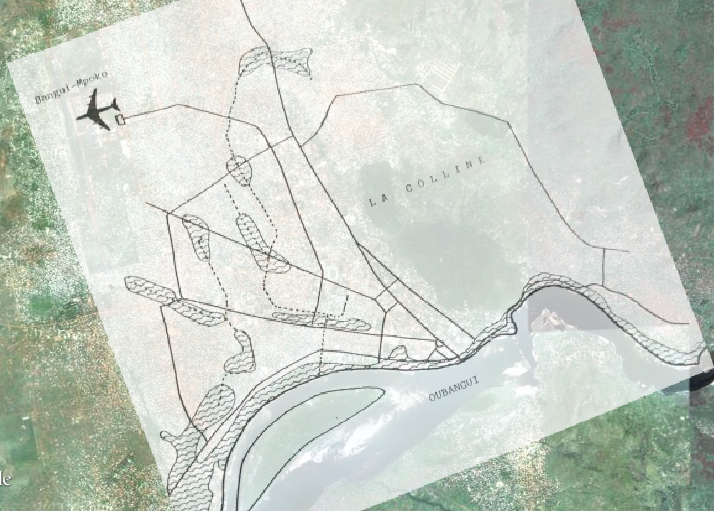- Continue to rectify the African city plans assigned to you (3–4 cities). Provide screenshots of these rectified maps on your blog.
- How is the “informal” conveyed within your city? Illustrate key informal/formal differences in spatial use through evidence provided in local newspaper, blog, or website insights. Map some aspect of this “informal”/”formal” dynamic with AfricaMap and/or Google Earth. Provide screenshots.
Excuse the slight departure from the assignment here: as I have mentioned before, Bangui’s Internet presence is next to nonexistent. What’s more, the news websites that do exist, for whatever reason, largely limit their coverage to the city’s formal sector. Their economic sections cover deals between the Central African government and foreign beneficiaries, or European countries that have won contracts to extract the country’s resources, but not the informal sector which has so much greater an effect on people’s everyday lives. There is one blog, La Lettre de C.B.M., which seems to give sharp and cynical social commentary. Naturally, of course, it’s not online right now.
In any case, Bangui’s informal economy has been studied in other contexts, so I will draw the contents of this post largely from scholarly sources.
A dichotomy between the formal and informal sectors of the economy exists in most, if not all, African cities. In Bangui, however, their relative sizes are more pronounced. It all goes back to colonial neglect: As France essentially did not care to develop Bangui beyond the tiny enclave that was the European city, at the time of independence there was barely any formal economy. As a result, in 2012, there is still barely any formal economy.
Bangui’s formal economy is, in simple numerical terms, woefully incapable of supporting large numbers of employees. Jobs in government ministries, international organizations and legitimate private-sector companies are exclusively limited to those with university education, but even among that subset of the population there is fierce competition. Additionally, in spatial terms, formal jobs are geographically inaccessible to the vast majority of the population. (More on that later.)
What of the rest? The remainder of Bangui’s population, though not officially employed, forms the lifeblood of its economy. They are street vendors, taxi drivers and repairpeople. They provide essential services for which the formal sector is unequipped, the services that are necessary for survival (Woodfork 147–148).
I did find one relevant article (after all that, one!). It was in the Journal de Bangui of 9 March 2012, and it reports on women selling salted fish in the streets. One is quoted as referring to fish-vending as a better way for women to support themselves than “whining” at their husbands (Journal de Bangui). This informal action is a good example of women collectively filling a void in the formal economy (affordable food) and at the same time advancing themselves.
Spatially, the dichotomy between formal and informal economy resembles the dichotomy between the planned and unplanned areas of the city. The relatively small former European city is the only place where one will find a formal economy, and yet it too is home to many informal economic activities. (The fish-sellers in the above article were stationed in front of Bangui’s main cathedral.) Outside of the city center, once the squatter settlements begin, there is only informal—and yet, this is really the economic heart of the city. Whereas the Marché Centrale specializes in luxury goods and imports, most Banguissoises do their shopping in the markets of Kilomètre 5 (informally K-Cinq, pronounced [ka sãk˺]) and other outlying areas of the city, where they can find affordable produce, clothing and other necessities (Villien et al. 140–141).
 |
| Informality is hard to map. I attempted, here, to find and highlight all the agglomerations of structures that looked like marketplaces in one area of Bangui, to give an idea of the prominence of informal markets in otherwise residential areas. (The big one on the top is Kilomètre 5.) See the interactive map here. |
Rectification
Ah, yes. This might be my last map. It is of the Brazzaville region, back when the city across the river was called Léopoldville (and not Kinshasa). The other three I have been assigned are of Ouagadougou, Burkina Faso, but they may not actually be available to rectify. See the Brazzaville map below.
 |
| I rectified this using the latitude and longitude reference points in the corners of the map. They weren’t precisely accurate, but they were close enough that I decided to let it go. See the interactive map here. |
References
Reseau des Journalistes R.C.A. “Bangui: Des Femmes Centrafricaines à La Recherche De Leur Autonomie.” Journal de Bangui, sec. Economie & Business: Web. 9 March 2012.
Villien, François, et al. Bangui, Capitale d’un Pays Enclavé d’Afrique Centrale : Étude Historique et Géographique. 4 Vol. Talence: Centre de Recherches sur les Espaces Tropicaux, Institut de Géographie, Université de Bordeaux III, 1990. Print.
Woodfork, Jacqueline. Culture and Customs of the Central African Republic. Westport: Greenwood Press, 2006. Print.

















